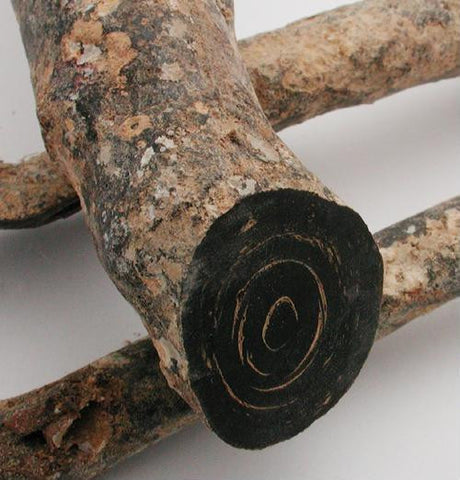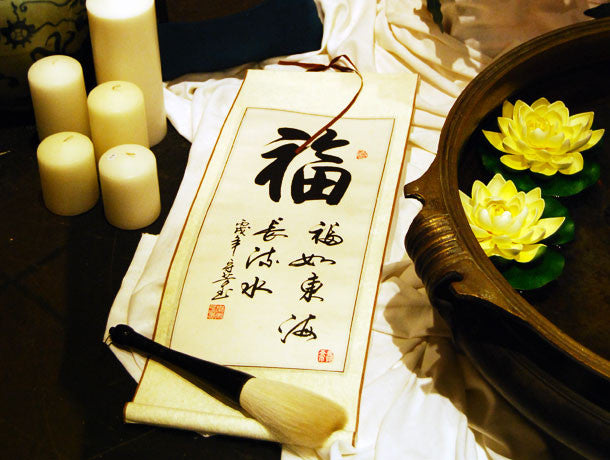Your Cart is Empty
Free Shipping for orders over $49 in Australia, $199 IN NEW ZEALAND/USA/CANADA AND $249 REST OF THE WORLD
Free Shipping for orders over $49 in Australia, $199 IN NEW ZEALAND/USA/CANADA AND $249 REST OF THE WORLD
Add description, images, menus and links to your mega menu
A column with no settings can be used as a spacer
Link to your collections, sales and even external links
Add up to five columns
Add description, images, menus and links to your mega menu
A column with no settings can be used as a spacer
Link to your collections, sales and even external links
Add up to five columns
Coral
by Linda Heaphy March 23, 2017
Coral is the term used to describe a vast group of marine invertebrates (animals without backbones) that collectively belong to the Phylum Cnidaria of the Class Anthozoa. While many people know of the red coral used in jewellery making, they would be surprised to learn that the term actually applies to at least 100,000 known species found throughout the world's seas, from the polar regions to equatorial reefs and at all depths from the intertidal zone to the bottoms of the deepest oceanic trenches - and scientists estimate that there may be another 900,000 species awaiting discovery. Many may also be surprised to learn that corals are animals, not plants. The tiny individuals, known as polyps, continuously excrete the calcium carbonate scaffolding that houses them, forming communal colonies that may be small and delicate or huge barrier reefs. Corals also occur naturally in just about every color imaginable, from shades of white, orange, pink, red, tan, gray, lavender and blue, all the way through to black.
Corals may be subdivided into two broad subclasses. The first is Alcyonaria, containing the "soft" corals, which means that their skeletons are always internal. These include the bamboo corals and the so called "gorgonian" corals, comprising sea pens, sea fans, gold corals, most pink to red corals, blue coral and organ pipe coral. The second subclass Zoantrharia contains the sea anemones, the stony reef-building corals that form massive barrier reefs and the solitary black, thorny corals. Corals play a vital role in helping to maintain the sea's delicate ecological balance and provide food and shelter for countless millions of other organisms. As a renewable human resource, corals are the slowest growing organisms of any known fishery past or present.
History of Use
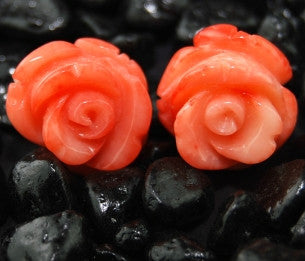
Coral rosebud carved earrings. Photo credit: Kashgar
Today coral is classified along with pearls, ivory and amber as an "organic" gem, however it is only relatively recently that its animal nature has been known. In ancient times it was considered to be simultaneously animal, vegetable and mineral, and until the 1700's naturalists believed coral to be a marine plant that petrified when removed from water.
Coral has been valued and used for jewellery fabrication and decoration since the earliest history of man. It was used as a form of currency along with amber by Paleolithic man and pieces of Mediterranean coral have been found in the Neolithic city of Catal Huyuk, Central Anatolia that date to 8,000 years BCE. In ancient Egypt coral jewels were popular during the times of Ptolemy, over 2000 years ago. Coral was traded across the ancient and modern world via established trade routes to Italy, where the major workshops were located, and then to Central Europe, Siberia and the Celtic countries, while other types of coral traveled from the Indian Ocean across Asia to Tibet and Mongolia. The Victorians adored coral, carving it into delicate roses and cameos, and since the late 1800's American Indians have incorporated red coral into many of their jewellery designs to take into account the tastes of settlers and tourists. Today coral is equally prized in jewellery making, while live corals and products such as coral rock have become increasingly popular in the marine aquarium trade.
Since ancient times coral was believed to cure madness, give wisdom, prevent sterility, calm storms, promote positive forms of social activity and provide protection against plague and pestilence. It was also thought to enable travellers to cross rivers safely. Red coral symbolises attachment and devotion. Amongst tribal cultures past and present it is universally believed to ward off the evil eye and bad luck, and it is still common for children and young women to wear coral necklaces (or even ceramic coral imitations, called "mountain coral" in the trade) for protection. In Vedic astrology red coral is associated with the planet Mars.
Coral Usage Today
Although as many as 1 million species of coral exist today, only 40 or so are subject to commercial usage. These may be summarised as follows:
Red - Pink - White or Precious Coral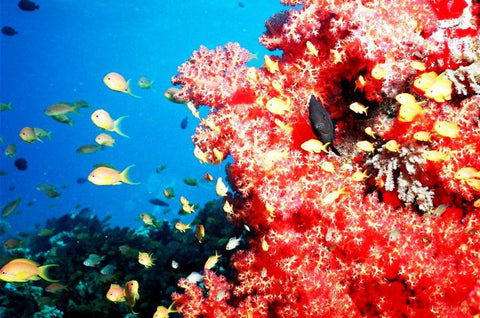 The so-called "precious" or red - pink - white corals belong to the Genus Corallium. Twenty-five species of Corallium have been named, of which six species are commonly traded, including the famous Mediterranean red coral (Corallium rubrum), the Pacific Ocean species Hawaiian pink coral (C secundum), red coral (C regale), pink coral (C laauense), and the Midway deep sea coral (Corallium sp nov).
The so-called "precious" or red - pink - white corals belong to the Genus Corallium. Twenty-five species of Corallium have been named, of which six species are commonly traded, including the famous Mediterranean red coral (Corallium rubrum), the Pacific Ocean species Hawaiian pink coral (C secundum), red coral (C regale), pink coral (C laauense), and the Midway deep sea coral (Corallium sp nov).
Coralliums are very slow growing - Mediterranean red coral at rates of less than 1mm per year and the Pacific Ocean species between 3 and 8mm per year. They are also relatively long lived, attaining ages of up to 75 years old, and heights of up to 1 metre. Mediterranean red coral is found in depths of 10 to 280 metres, often in caves and crevices, while the red and pink corals of the west Pacific are found at depths of 350 -1500 m and prefer areas with moderate to strong water currents.
Mediterranean red coral (which can itself range in colour from pale orange to the deepest of oxblood reds) had been used for thousands of years in the production of jewellery, religious objects and medicine, and remains the most highly valued of all the corals. Italy is the main producer of red coral objects and still holds large stockpiles harvested prior to the 1980's. Pink coral, also considered very desirable by the jewellery industry, is very dense and relatively hard. It can span the entire spectrum of pinks, from almost white to nearly red. While all shades of pink coral are coveted, pale pink Angelskin coral is preferred by the jewellery industry.
Because of their slow growth and value to the jewellery industry, the red-pink-white corals are vulnerable to over-exploitation and many populations in both the Mediterranean and the Pacific have been over-harvested; yields from the Mediterranean have been reduced by 66 percent in the last 25 years. In the past these corals were harvested using non-selective dredging equipment that caused widespread damage, not only to the coral colonies but also to entire undersea habitats. Dredging has now been banned throughout the Mediterranean Sea and around Hawaii and harvesting is carried out using more selective methods such as scuba diving or submersible collection. Somewhat surprisingly, the Coralliums are not listed in either Appendix I or II of the Convention on International Trade in Endangered Species (CITES), although their trade is controlled via other international fishery management Directives and they are often subject to strict domestic legislation.
Red coral branch of the species Corallium rubrum from Italy (height - 4.9 cm) ready for jewellery making. Note that the colour is natural and not added with dyes. Photo credit: Jeffrey A. Scovil.
Precious corals, irrespective of their colour or origin, may be identified in hand specimens by their solid dense texture, few holes being visible in its polished external surface other than clusters of pin point holes, and the presence of parallel longitudinal striations on the surface of the coral. Close examination should also distinguish between natural and reconstituted coral, which is made from coral fragments that have been pulverised into a powder, soaked in binding agents, then pressed into a solid mass to be re-cut and dyed. Red corals may also be imitated in tribal cultures with ceramic materials, but carry none of the imperfections and striations associated with natural corals.
Black coral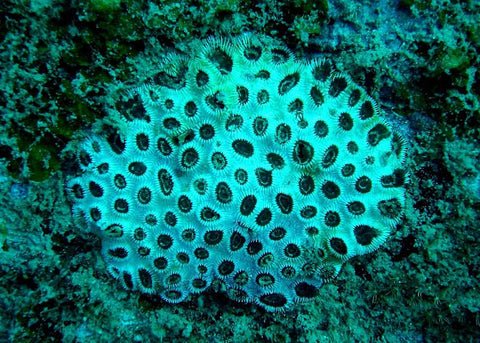 Black coral in situ (unidentified Scleractinia). Photo credit: Aaron
Black coral in situ (unidentified Scleractinia). Photo credit: Aaron
The black corals belong to 4 separate families, the Antipathidae, Leiopathidae, Schizopathidae and Myriopathidae containing 150 species so far identified, of which 8 are subject to international trade. Black corals are covered in spines and may be either branching or wire-like without branches and when alive are white, yellow, orange, red or green in colour. Colonies may reach up to 1.8 m in height and are distributed worldwide. Small fisheries for black coral exist in all oceans but are most developed in the Indo-Pacific and Caribbean regions.
Black coral colonies are slow growing and long-lived. They are found at a wide range of depths, from 1 - 6000 metres, but are generally distributed between 30 and 80 metres. They tend to be associated with strong currents and low light conditions, either by growing in deep water or in turbid areas of shallow water.
Because of their unusual and lightweight nature, black corals are highly valued and have been used for centuries in jewellery making and as medicine. An aquarium trade in live specimens has also been reported. Harvesting is mainly carried out by divers and by submersibles, although net dredging has been used in the past. Black corals are slow to recover from harvesting and are currently considered to be globally threatened. Some black corals are listed in CITES Appendix II, which means that a CITES export permit is required to bring anything made from black coral into the 158 countries that have ratified the Convention (this includes the UK, other countries in the European Community, the USA, Canada, and Australia). In addition to CITES the export of black coral is banned or restricted by a number of countries. However it should be noted that harvesting in some locations such as Hawaii is carefully and responsibly managed to ensure that collection is sustainable.
Unpolished rough black coral sticks. Photo credit: Peter Rohm,
Rohm GmbH & Co Kg, Linz, Austria.
Black corals may be identified by their tree-like rings in cross-section, the appearance of spiny stub-ends in polished material and a 'salty burnt hair' aroma when a hot point is applied to the surface. Black corals are also far lighter than other corals and have a red-brown appearance under strong light.
Bamboo Coral

Bamboo coral (Keratoisis sp.), discovered at 1,455 m depth at Davidson Seamount. Photo credit: NOAA/MBARI 2002.
Bamboo corals belong to the Family Isidiae of which it is estimated there are some 38 genera and 138 species worldwide - estimated because new species are still being described on a regular basis. In spite of the fact that bamboo corals have now largely taken the place of the red corals in jewellery manufacture, very little is actually known about them. Currently four species across four genera are harvested for commercial purposes.
Bamboo corals get their name from the distinctive appearance of their jointed skeletons, with long white nodes separated by striking black internodes, just like their land based namesakes. They live mainly on the deep-ocean floor at depths greater than 1 km and while they are found in oceans all over the world, the greatest concentrations are distributed around New Zealand and some other areas of the Pacific such as the Philippines. All coral species are long-lived, but it is thought that some species of bamboo coral can live for centuries, possibly even thousands of years (that is, colonies, not individual polyps). They may also grow several metres high, forming dense thickets that provide vital habitat for small invertebrates and nurseries for many commercial fish species. Because they are so long lived and also form growth rings just like trees, bamboo corals may be ideal for studying climate changes across centuries.
Natural bamboo coral is a creamy white to grey colour with a discernible dark core, however it readily takes dye and is often coloured pink or red in imitation of Mediterranean coral. Most of the new and legal coral coming onto the market today is likely bamboo coral from the Philippines and China.
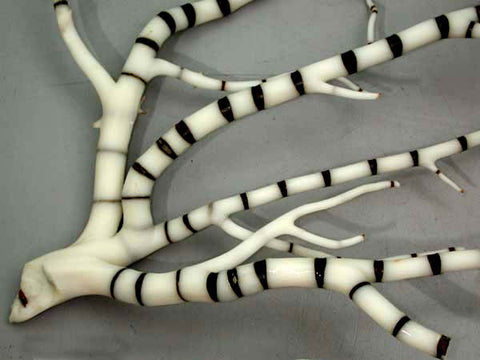
A bamboo coral skeleton (Ceratoisis flexibilis) with living tissue removed.
Photo credit: NOAA
When whole, bamboo coral is easy to distinguish from other corals because of its bamboo-like appearance. In cross section it typically has tree like rings and a dark rough core. When colour enhanced and cut into beads it can be difficult to distinguish from the precious corals. Besides basic dipping, the coral may be injected with dye to saturate it all the way through. It may be possible to distinguish dyed bamboo from precious coral beads by the evenness of colour, ie a lack of striation or colour variation of any sort within or between beads - for this the use of a 10x eyeglass is recommended.
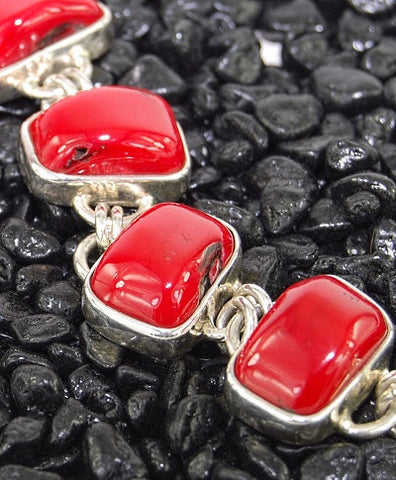
Dyed bamboo coral. Note the lack of striation and large black inclusions.
Photo credit: Kashgar.
It should be emphasised that bamboo corals are a legal and much less expensive alternative to the precious corals. They now satisfy much of the public demand for coral products, which in turn is allowing the recovery of the Mediterranean and Pacific colonies and their associated eco habitats. This is true so long as the coral is correctly identified to the buyer as bamboo and not as one of the precious corals.
Sponge Corals

Knotted fan coral (Melithaea ochracea), Pulau Tioman, West Malaysia.
Photo credit: Anders Poulsen, Deep Bluehttp://www.colours.dk
The so-called sponge or soft corals are neither particularly soft nor spongy. Their name comes from the very open skeleton that they secrete, full of holes and irregular surfaces. They are primarily found in shallow, tropical and sub tropical waters and are relatively short-lived compared to their deeper water cousins. There are many hundreds of species which occur in a variety of natural colours, but only two types are utilised in the jewellery industry, the red and blue sponge corals (a much larger number of species are popular with the aquarium trade).
Red Spongy Coral (Melithaea ochracea) is relatively new to the jewellery industry, but is fast growing in popularity because of its availability and relatively low price. Fan shaped and naturally red in colour with yellow-orange-brown streaks, it must be stabilized with resins because of its highly porous nature. Poorer quality material may be dyed, and it is reported that China and Indonesia may also be pressing fragmented material. Red spongy coral is harvested in the South China Sea, from Taiwan to Indonesia, and is now apparently being farmed in some of these areas. Red spongy coral is not an endangered species, is not listed with CITES and is considered worldwide to be a sustainable resource.
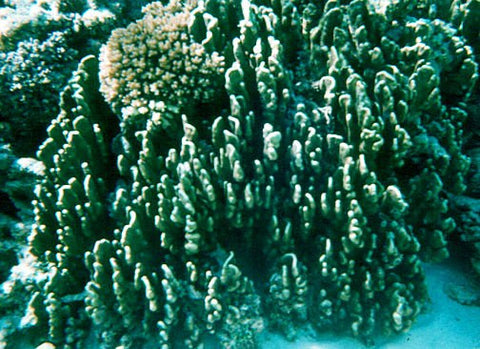
Heliopora coerulea, Samoa, America, 2014
http://www.botany.hawaii.edu/basch/uhnpscesu/htms/NPSAcorl/fish_pops/heliopor/coral02.htm
Blue Spongy Coral (Heliopora coerulea) can be tree-like, plate-like or column-like and may reach several metres in height. It is considered to be an important reef-building coral in the Indo-Pacific oceans, with the largest colonies being found around Japan and Hawaii. Its blue colour is caused by the deposition of iron salts in its calcium carbonate skeleton. While blue spongy coral has some popularity in the jewellery industry (it requires stabilisation just like it's red cousin), it is mainly harvested for the live aquarium and marine curio trades. However, the species is considered threatened and is listed in CITES Appendix II. In addition several countries have legislation banning or limiting the collection or trade of blue coral.
In jewellery, spongy corals may be easily identified by their very porous, variegated and streaky surface.
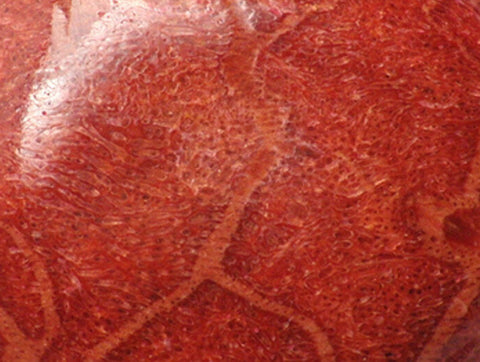
Spongyform red coral polished and ready for jewellery making.
Photo credit: Kashgar
Gold Corals
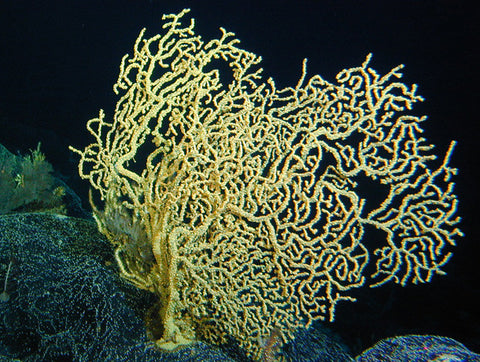
Geradia sp. (gold) coral Photo credit: NOAA Hawaiian Undersea Research Lab
Of all the corals, the golds are probably the least well studied. There are only four known species that occur within three Families; Narella sp, Gerardia sp, Callogorgia gilberti and Calyptrophora sp.
These corals are particularly unusual in that they secrete a golden keratin protein but no calcium carbonate. They are also considered "parasitic" in that they settle as free-swimming larvae onto the skeletons of other corals, eventually overgrowing and smothering them. They mostly occur in deep waters, are associated with the bamboo coral colonies they like to colonise and may be the slowest-growing of all the coral species, with colonies reaching thousands of years in age. Unlike the bamboo corals, the golds may only lay down their growth rings once a decade.
Gerardia sp. is legally and commercially harvested from Hawaiian waters, and this is the primary source of the small amount of gold coral jewellery that finds its way onto the market. While the gold corals are not listed in either of the CITES Appendices, their limited distribution, extremely slow growth rates and poorly understood biology suggest that a market for gold corals should not be developed or encouraged.
Gold coral may be identified by its tree like growth rings in cross section, it's even gold colour and dimpled surface, and a 'burnt hair' aroma when a hot point is applied to it's surface.
More recently, Lawrence Livermore National Laboratory scientists have used the skeleton of Geradia sp. coral as a strip-chart recorder for what the coral has fed upon. Because these deep sea corals are some of the oldest living marine organisms known to man, they serve as a useful record keeper for ocean and climate changes.
Care and Maintenance of Coral in Jewellery
Because of its relative softness (3 ½ to 4 on Mohr's scale), coral can scratch and abrade easily. Bright lights may cause it to darken while excessive heat can damage the finish. Acids (even those found in sweat) or solvents such as the chlorine in swimming pools, alcohol, nail polish remover and make up remover will soften coral over time. For these reasons, coral jewellery should be removed when washing hands or remving makeup, should not be worn in the shower and should never be left on window sills or in the sun. Coral is best stored in a cloth bag in an environment with an even temperature and humidity.
Updated 28th March 2017
References and Further Reading:
Brown, G. (1976) Two new precious corals from Hawaii. Australian Gemologist. 12, 371-377.
Brown, G. (1988) Bamboo coral: A new precious coral from Hawaii. Australian Gemologist. 16, 449-454.
Dietrich, RV (2015) Corals. http://stoneplus.cst.cmich.edu/zoogems/coral.html
Etnoyer P (2002, revised 2008) What Species is a Bamboo Coral?www.oceanexplorer.noaa.gov http://oceanexplorer.noaa.gov/explorations/02alaska/logs/jul14/jul14.html
Grigg, R. & Brown, G. (1991) Tasmanian gem corals. Australian Gemmologist. 17, 399-404.
Lawrence Livermore National Laboratory (2015) Scientists discover shifts in climate-sensitive plankton over the past millennium. Accessed 28th March 2016.
www.wpacfin.nmfs.hawaii.edu
Staff Report (March 5th 2009) Discovery - 7 New Species Of Bamboo Coral Near Hawaii. Scientific Blogging Science 2.0http://www.scientificblogging.com/news_releases/discovery_7_new_species_bamboo_coral_near_hawaii
Sánchez J, Tracey D, Neil H and Marriott P (2004) Coral Rings in the Deep Ocean: using SEM to date New Zealand's bamboo corals NIWA Science Vol.12 No.4http://www.niwa.cri.nz/pubs/wa/ma/12-4/coral
Wikipedia. Coral. Referenced 16 April 2009http://en.wikipedia.org/wiki/Coral
Visit our store
Leave a comment
Comments will be approved before showing up.
Also in Jewellery & Stones
Articles
About the Author
- Linda has a Honours degree in Marine Biology and a PhD in Ecology from the University of NSW, Australia. She has travelled extensively and is a passionate writer on subjects as diverse as the role played by women throughout history, tribal communities and their customs, symbology and ethnology, talismans and their history. Occasionally she also writes about her travel experiences, her new life on a 25 acres in the Northern Rivers region of northern Australia and her black miniature poodle Phoenix. She is currently writing her first book on talismans.
About Us
-
The Kashgar Philosophy

Kashgar began through a love of travel.
In 1989 my father Bernard packed in his house painting business and set off for two years on a backpacking trek to the remotest corners of the world. When he finally arrived in the oasis city of Kashgar, China, he was so impressed with its history that he decided to start a new life collecting and selling exotic goods from all over the world. For 2000 years the legendary city of Kashgar was a melting pot of ideas and a key trading post on the historic Silk Road. It was this unique combination of philosophy and trade that my father wanted to recreate at home.
Starting in markets in 1991, he opened his first store in the Sydney suburb of Newtown in 1994. I gave up my own career as a government scientist to join him in 2000 and soon convinced my partner Ian to join us in what was to become the Family Business.
Today our version of Kashgar stocks a hugely diverse range of furniture, rugs, textiles, antiques, handicrafts and jewellery sourced from over twenty different countries including India, Nepal, Tibet, China, Thailand, Burma, Laos, the Philippines, Vietnam, Mexico, Peru, Turkey, Palestine, Syria, Afghanistan and Turkmenistan. Our collection includes contemporary and tribal silver and gold jewellery, a unique range of headhunting curios, antique Buddhist relics and a collection of one-off necklaces, earrings and bracelets that I design and create myself using the beads and jewellery making techniques of ethnic minorities from around the globe.
Kashgar is a philosophy as well as a store. We are committed to supporting traditional artisans and small village communities by selling authentic handcrafted goods which are personally collected by us. By supporting traditional methods of design and production we hope to encourage local cottage industries which have a low impact on the environment and help ethnic minorities maintain their self-sufficiency into the 21st Century. We are particularly committed to assisting women around the world and to this end have worked with several organisations including the Hua Bin Women's Union of Vietnam, the East Timorese Women's Association and Tikondane in Zambia. Time honoured means of craftsmanship and traditional ways of life are disappearing as people all over the world give up their identity in favour of jeans and T-shirts. We see our trade as a means of staving off the inevitable encroachment of the 21st century, assisting communities to decide for themselves which parts of the western world they wish to incorporate (medicine, education) and which they wish to reject (prostitution, drug production, begging and servitude to warlords). We encourage our customers to think of the handicrafts and artifacts they buy from us as an investment: a piece of history and a way of life that may soon be gone forever.
Kashgar has recently closed its retail outlet and gone completely online.
In the past our pieces appeared in many movies including The Hobbit, Mission Impossible 2, Queen of the Damned, Scooby Doo, Moulin Rouge and Wolverine, and in many televisions series, as well as in plays, commercials and exhibitions. We've found special pieces for individual customers as well as for film sets, event management companies, hotels, businesses, consulates and embassies. The uniqueness of our stock means that we are also very appealing to interior and fashion designers with a taste for the exotic.
There is something for everyone at Kashgar - collectors, the curious, those looking for a special present or for something unique to adorn the home. Most of our items are one-off specialties; other pieces we only stock in small quantities so as to continuously offer a wide and ever-changing range of interesting products. We are also packed with ideas for decorating home and work premises that will challenge your established concepts of design and storage.

Please enjoy - Linda Heaphy
Become a Kashgar nomad and join our mailing list...
Sign up to get the latest on sales, new releases and more …

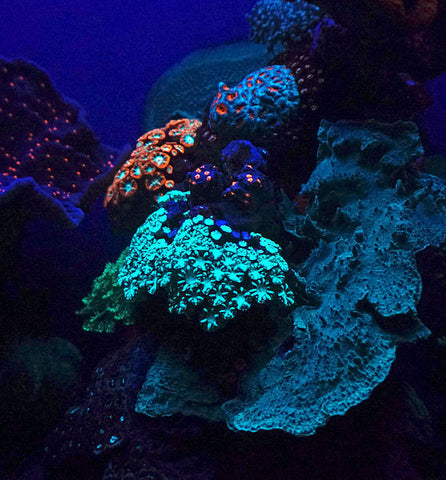 Fluorescent coral in Underwater Observatory Marine Park, Eilat.
Fluorescent coral in Underwater Observatory Marine Park, Eilat. 
